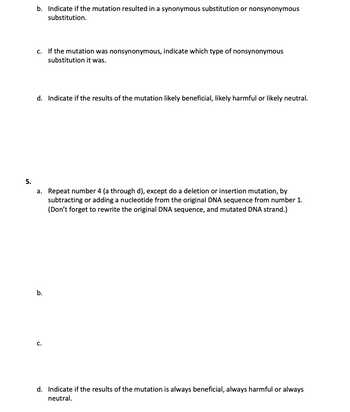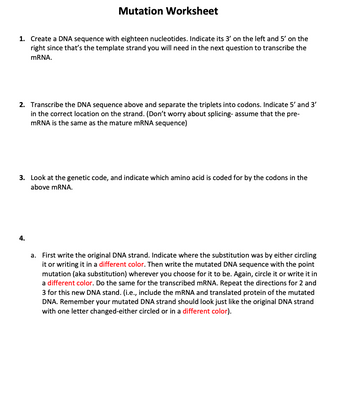
Concept explainers
ANSWERS 1-3 were answered but I need 4 and 5 answered please.
Three parts are solved in case of interlinked question as per our company policy. If you want assistance with other parts, please post separately.
The DNA is made up of deoxyribonucleotide sub units. It is the genetic material.
The deoxyribonucleotides consist of deoxyribose sugar, phosphate group and nitrogenous bases. Nitrogenous bases are adenine, guanine, thymine and cytosine.
Answer 1) The sequence of template strand in 3' to 5' sequence is:
3' TACCCGCCAGCCTACATC 5'
Answer 2)
The mRNA strand is complementary to the template strand. The RNA polymerase synthesises mRNA. The A, U, G and C are present in mRNA with respect to the T, A, C and G in DNA.
The mRNA sequence is: 5' AUGGGCGGUCGGAUGUAG 3'
The mRNA sequence in form of codon is: 5' AUG GGC GGU CGG AUG UAG 3' The codon is made up of three nucleotides.
Answer 3) The mRNA codon chart helps to find the sequence of amino acid from a codon. The start codon initiates translation. Sto codon (UAA, UAG or UGA) terminates translation. The protein sequence is: N- met- gly- gly- arg- met- C
4. ANSWER BELOW QUESTIONS:
A. First write the original DNA strand. Indicate where the substitution was by either circling it or writing it in a different color. Then write the mutated DNA sequence with the point mutation (aka substitution) wherever you choose for it to be. Again, circle it or write it in a different color. Do the same for the transcribed mRNA. Repeat the directions for 2 and 3 for this new DNA stand. (i.e., include the mRNA and translated protein of the mutated DNA. Remember your mutated DNA strand should look just like the original DNA strand with one letter changed-either circled or in a different color).
B. Indicate if the mutation resulted in a synonymous substitution or nonsynonymous substitution.
C. If the mutation was nonsynonymous, indicate which type of nonsynonymous substitution it was.
D. Indicate if the results of the mutation likely beneficial, likely harmful or likely neutral.
5. ANSWER BELOW QUESTIONS:
A. Repeat number 4 (a through d), except do a deletion or insertion mutation, by subtracting or adding a
B.
C.
D. Indicate if the results of the mutation is always beneficial, always harmful or always neutral.


Trending nowThis is a popular solution!
Step by stepSolved in 2 steps

Where is the substitution indicated on the original DNA strand? May you please Write it out and bold the
Where is the substitution indicated on the original DNA strand? May you please Write it out and bold the
- Confirm Regularly bring your favourites, password... of 45 OCR 2021. You may photocopy this page. 7 of 46 Create 4 Which of the following nucleotides contains uracil? A B NH H,C. ofo HN HO-P-O- HO-P-O- OH ОН ОН OH 'NH HO-P- NH, HO-P-O OH ОН ОН OH Your answer An anticodon seguence of five successsive tRNA molecules involved in protein sunthosie was ararrow_forwardQuestion 9arrow_forward(THIS IS NOT GRADED.) This is NON-MANDATORY homework for a practice assessment. I need some assistance with these questions, so I can use them for studying material. Thank you so much! I highly appreciate it! (I am using this for study material.)arrow_forward
- Question 1 options: The specificity pocket of the serine protease chymotrypsin, which interacts with Tyr and Phe-containing peptide sequences, contains a Ser residue. A research group is trying to modify chymotrypsin such that it has a low KM with Trp-containing peptides. Enter the name or abbreviation of an amino acid that the Ser could be mutated to that would likely have the desired effect. (Hint: look at the diagrams of the specificity pockets shown in the course slides, and consider how the Ser would need to change to account for the difference between Tyr/Phe and Trp.)arrow_forwardQuestion 5 Translocation O occurs before peptide bond formation O moves the RNA four bases moves the RNA three bases. O none of the above A Moving to another question will save this response. MacBook Proarrow_forwardOnly need help with parts a,b and c please, and thank you!arrow_forward
- A Moving to another question wil save thes response Question 28 Multiple Answer Question: Which of the following statements about the Watson-Crick model of DNA structure (also called the B-form of DNA) isiare TRUE? OA The bases of two nucieotides in a base-pair are held together by covalenit bonds. O8. The base pairing of nucleobases occurs on the inside of the double helox, OC The two DNA strands run antiparallel in the opposite directions OD. Tne sugar phosphate backbone is located on the outside of the double holiox CIE The two DNA strands have identical nucleotide sequences OF. The double helix is night-handedarrow_forwardThe typed picture is how my teacher did it and he wants me to solve the hand written one and I have no clue on how to do it , if you can solve it with steps on how to it it would be incredible helpful thanks !arrow_forwardI need help on Part Barrow_forward
 Human Anatomy & Physiology (11th Edition)BiologyISBN:9780134580999Author:Elaine N. Marieb, Katja N. HoehnPublisher:PEARSON
Human Anatomy & Physiology (11th Edition)BiologyISBN:9780134580999Author:Elaine N. Marieb, Katja N. HoehnPublisher:PEARSON Biology 2eBiologyISBN:9781947172517Author:Matthew Douglas, Jung Choi, Mary Ann ClarkPublisher:OpenStax
Biology 2eBiologyISBN:9781947172517Author:Matthew Douglas, Jung Choi, Mary Ann ClarkPublisher:OpenStax Anatomy & PhysiologyBiologyISBN:9781259398629Author:McKinley, Michael P., O'loughlin, Valerie Dean, Bidle, Theresa StouterPublisher:Mcgraw Hill Education,
Anatomy & PhysiologyBiologyISBN:9781259398629Author:McKinley, Michael P., O'loughlin, Valerie Dean, Bidle, Theresa StouterPublisher:Mcgraw Hill Education, Molecular Biology of the Cell (Sixth Edition)BiologyISBN:9780815344322Author:Bruce Alberts, Alexander D. Johnson, Julian Lewis, David Morgan, Martin Raff, Keith Roberts, Peter WalterPublisher:W. W. Norton & Company
Molecular Biology of the Cell (Sixth Edition)BiologyISBN:9780815344322Author:Bruce Alberts, Alexander D. Johnson, Julian Lewis, David Morgan, Martin Raff, Keith Roberts, Peter WalterPublisher:W. W. Norton & Company Laboratory Manual For Human Anatomy & PhysiologyBiologyISBN:9781260159363Author:Martin, Terry R., Prentice-craver, CynthiaPublisher:McGraw-Hill Publishing Co.
Laboratory Manual For Human Anatomy & PhysiologyBiologyISBN:9781260159363Author:Martin, Terry R., Prentice-craver, CynthiaPublisher:McGraw-Hill Publishing Co. Inquiry Into Life (16th Edition)BiologyISBN:9781260231700Author:Sylvia S. Mader, Michael WindelspechtPublisher:McGraw Hill Education
Inquiry Into Life (16th Edition)BiologyISBN:9781260231700Author:Sylvia S. Mader, Michael WindelspechtPublisher:McGraw Hill Education





